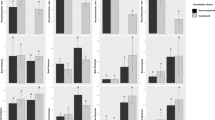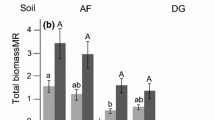Abstract
Although it is usually admitted that arbuscular mycorrhizal (AM) fungi are key components in soil bio-functioning, little is known on the response of microbial functional diversity to AM inoculation. The aims of the present study were to determine the influence of Glomus intraradices inoculum densities on plant growth and soil microflora functional diversity in autoclaved soil or non-disinfected soil. Microbial diversity of soil treatments was assessed by measuring the patterns of in situ catabolic potential of microbial communities. The soil disinfection increased sorghum growth, but lowered catabolic evenness (4.8) compared to that recorded in the non-disinfected soil (6.5). G. intraradices inoculation induced a higher plant growth in the autoclaved soil than in the non-disinfected soil. This AM effect was positively related to inoculum density. Catabolic evenness and richness were positively correlated with the number of inoculated AM propagules in the autoclaved soil, but negatively correlated in the non-disinfected soil. In addition, after soil disinfection and AM inoculation, these microbial functionality indicators had higher values than in the autoclaved or in the non-disinfected soil without AM inoculation. These results are discussed in relation to the ecological influence of AM inoculation, with selected fungal strains and their associated microflora on native soil microbial activity.


Similar content being viewed by others
References
Alguacil MM, Caravaca F, Roldan A (2005) Changes in rhizosphere microbial activity mediated by native or allochthonous AM fungi in the reafforestation of a Mediterranean degraded environment. Biol Fertil Soils 41:59–68
Andrade G, Mihara KL, Linderman RG (1998) Soil aggregation status and rhizobacteria in the mycorrhizosphere. Plant Soil 202:89–96
Andrews JH, Harris RF (1986) r- and K-selection in microbial ecology. Adv Microb Ecol 9:99–147
Bethlenfalvay GJ, Cantrell IC, Mihara KL, Schreiner RP (1999) Relationships between soil aggregation and mycorrhiza as influenced by soil biota and nitrogen nutrition. Biol Fertil Soils 28:356–363
Bever JD, Westover KM, Antonovics J (1997) Incorporating the soil community into plant population dynamics: the utility of the feed-back approach. J Ecol 85:561–573
Caravaca F, Alguacil MM, Figueroa D, Barea JM, Roldan A (2003) Re-establishment of Retama sphaerocarpa as a target species for reclamation of soil physical and biological properties in a semi-arid Mediterranean area. For Ecol Manag 182:49–58
Curl EA, Truelove B (1986) The rhizosphere. Springer, Berlin, p 288
Degens BP, Harris JA (1997) Development of a physiological approach to measuring the catabolic diversity of soil microbial communities. Soil Biol Biochem 29:1309–1320
Degens BP, Vojvodic-Vukovic M (1999) A sampling strategy to assess the effects of land use on microbial functional diversity in soils. Aust J Soil Res 37:593–601
Degens BP, Schipper LA, Sparling GP, Vojvodic-Vukovic M (2000) Decreases in organic C reserves in soils can reduce the catabolic diversity of soil microbial communities. Soil Biol Biochem 32:189–196
Degens BP, Schipper LA, Sparling GP, Duncan LC (2001) Is the microbial community in a soil with reduced catabolic diversity less resistant to stress or disturbance. Soil Biol Biochem 33:1143–1153
Desgranges C, Vergoignan C, Georges M, Durand A (1991) Biomass estimation in solid state fermentation. I. Manual biochemical methods. Appl Microbiol Biotechnol 35:200–205
Duponnois R, Plenchette C, Bâ AM (2001a) Growth stimulation of seventeen fallow leguminous plants inoculated with Glomus aggregatum in Senegal. Eur J Soil Biol 37:181–186
Duponnois R, Plenchette C, Thioulouse J, Cadet P (2001b) The mycorrhizal soil infectivity and arbuscular mycorrhizal fungal spore communities in soils of different aged fallows in Senegal. Appl Soil Ecol 17:239–251
Duponnois R, Paugy M, Thioulouse J, Masse D, Lepage M (2005a) Functional diversity of soil microbial community, rock phosphate dissolution and growth of Acacia seyal as influenced by grass-, litter- and soil-feeding termite nest structure amendments. Geoderma 124:349–361
Duponnois R, Colombet A, Hien V, Thioulouse J (2005b) The mycorrhizal fungus Glomus intraradices and rock phosphate amendment influence plant growth and microbial activity in the rhizosphere of Acacia holosericea. Soil Biol Biochem 37:1460–1468
Duvert P, Perrin R, Plenchette C (1990) Soil receptiveness to VA mycorrhizal association: concept and method. Plant Soil 124:1–6
Estaun V, Save R, Biel C (1997) AM inoculation as a biological tool to improve plant re-vegetation of a disturbed soil with Rosmarinus officinalis under semi-arid conditions. Appl Soil Ecol 6:223–229
Flannery MB, Stott AW, Briggs DEG, Evershed RP (2001) Chitin in the fossil record: identification and quantification of d-glucosamine. Org Geochem 32:745–754
Franson RI, Bethlenfalvay GJ (1989) Infection unit method of vesicular arbuscular mycorrhizal propagule determination. Soil Sci Soc Am J 53:754–756
Gebre GM, Tschaplinski, TJ (2002) Solute accumulation of chestnut oak and dogwood leaves in response to throughfall manipulation of an upland oak forest. Tree Physiol 22:251–260
Giller KE, Beare MH, Lavelle P, Izac A-MN, Swift MJ (1997) Agricultural intensification, soil biodiversity and agroecosystem function. Appl Soil Ecol 6:3–16
Heinemeyer O, Insam H, Kaiser EA, Walenzik G (1989) Soil microbial biomass and respiration measurements: an automated technique based on infrared gas analysis. Plant Soil 116:77–81
Hunt S (1970) Chitin. In: Hunt S (ed) Polysaccharide–protein complexes in invertebrates. Academic, London, pp 129–147
Jasper DA (1994) Management of mycorrhiza in revegetation. In: Robson AD, Abbot LK, Malajszuk N (eds) Management of mycorrhizas in agriculture, horticulture and forestry. Kluwer, Dordrecht, The Netherlands, pp 211–219
Johansson JF, Paul LR, Finlay RD (2004) Microbial interactions in the mycorrhizosphere and their significance for sustainable agriculture. FEMS Microbiol Ecol 48:1–13
Klein DA, Metzger WC, Frederick BA, Redente EF (1986) Environmental stress-functional diversity relationships in semi-arid terrestrial microbial communities. In: Jensen V, Kjoller A, Sorensen LH (eds) Microbial communities in soil. Elsevier, London, pp 105–112
Linderman RG (1988) Mycorrhizal interactions with the rhizosphere microflora: the mycorrhizosphere effect. Phytopathology 78:366–371
Magurran AE (1988) Ecological diversity and its measurement. Croom Helm, London
Mansfeld-Giese K, Larsen J, Bodker L (2002) Bacterial populations associated with mycelium of the arbuscular mycorrhizal fungus Glomus intraradices. FEMS Microbiol Ecol 41:133–140
Marschner P, Baumann K (2003) Changes in bacterial community structure induced by mycorrhizal colonization in split-root maize. Plant Soil 251:279–289
Marshner P, Timonen S (2005) Interactions between plant species and mycorrhizal colonization on the bacterial community composition in the rhizosphere. Appl Soil Ecol 28:23–36
Marshner P, Crowley DE, Lieberei R (2001) Arbuscular mycorrhizal infection changes the bacterial 16S rDNA community composition in the rhizosphere. Mycorrhiza 11:297–302
Ouahmane L, Duponnois R, Hafidi M, Kisa M, Boumezzough A, Thioulouse J, Plenchette C (2006) Some Mediterranean plant species (Lavandula spp. and Thymus satureioides) act as potential “plant nurses” for the early growth of Cupressus atlantica. Plant Ecol 185:123–134
Phillips JM, Hayman DS (1970) Improved procedures for clearing roots and staining parasitic and vesicular-arbuscular mycorrhizal fungi for rapid assessment of infection. Trans Br Mycol Soc 55:158–161
Pianka ER (1970) On r- and K-selection. Am Nat 104:592–597
Piéri C (1991) Les bases agronomiques de l’amélioration et du maintien de la fertilité des terres des savanes au sud Sahara. In: Savanes d’Afrique, terre fertile? Actes des rencontres internationales. Montpellier, France, pp 43–74 (10–14 Décembre 1990)
Plenchette C (2000) Receptiveness of some tropical soils from banana fields in Martinique to the arbuscular fungus Glomus intraradices. Appl Soil Ecol 15:253–260
Plenchette C, Declerck S, Diop T, Strullu DG (1996) Infectivity of monoaxenic cultures of the AM fungus Glomus versiforme associated with Ri-TDNA transformed root. Appl Microbiol Biotechnol 46:545–548
Requena N, Perez-Solis E, Azcon-Aguilar C, Jeffries P, Barea JM (2001) Management of indigenous plant–microbe symbioses aids restoration of desertified ecosystems. Appl Environ Microbiol 67:495–498
Sanon A, Martin P, Thioulouse J, Plenchette C, Spichiger R, Lepage M, Duponnois R (2006) Displacement of an herbaceous plant species community by mycorrhizal and non-mycorrhizal Gmelina arborea, an exotic tree, grown in a microcosm experiment. Mycorrhiza 16:125–132
Sarathchandra SU, Burch G, Cox NR (1997) Growth patterns of bacterial communities in the rhizoplane and rhizosphere of white clover (Trifolium repens L.) and perennial ryegrass (Lolium perenne L.) in long-term pasture. Appl Soil Ecol 6:293–299
Schreiner RP, Mihara KL, McDaniel KL, Bethlenfalvay GJ (2003) Mycorrhizal fungi influence plant and soil functions and interactions. Plant Soil 188:199–209
Smith SE, Read DJ (1997) Mycorrhizal symbiosis, 2nd edn. Academic, San Diego
Stevenson BA, Sparling GP, Schipper LA, Degens BP, Duncan LC (2004) Pasture and forest soil microbial communities show distinct patterns in their catabolic respiration responses at a landscape scale. Soil Biol Biochem 36:49–55
Sylvia DM (1990) Inoculation of native woody plants with vesicular–arbuscular mycorrhizal fungi for phosphate mine lands reclamation. Agric Ecosyst Environ 31:253–261
Troelstra SR, Wagenaar R, Smant W, Peters BAM (2001) Interpretation of bioassays in the study of interactions between soil organisms and plants: involvement of nutrient factors. New Phytol 150:697–706
Van der Heijden MGA, Klironomos JN, Ursic M., Moutoglis P, Streitwolf-Engel R, Boller T, Wiemken A, Sanders IR (1998) Mycorrhizal fungal diversity determines plant biodiversity, ecosystem variability and productivity. Nature 396:69–72
Vazquez MM, Cesar S, Azcon R, Barea JM (2000) Interactions between arbuscular mycorrhizal fungi and other microbial inoculants (Azospirillum, Pseudomonas, Trichoderma) and their effects on microbial populations and enzyme activities in the rhizosphere of maize plants. Appl Soil Ecol 15:261–272
Wardle DA, Giller KE, Barker GM (1999) The regulation and functional significance of soil biodiversity in agro-ecosystems. In: Wood D, Lenné JM (eds) Agrobiodiversity: characterisation, utilisation and management. CABI, London, pp 87–121
West AW, Sparling GP (1986) Modifications to the substrate-induced respiration method to permit measurements of microbial biomass in soils of differing water contents. J Microbiol Methods 5:177–189
Acknowledgements
This work was supported by the CORUS Program (Project no. 02 313 518 198; French Minister of Foreign Affairs).
Author information
Authors and Affiliations
Corresponding author
Rights and permissions
About this article
Cite this article
Dabire, A.P., Hien, V., Kisa, M. et al. Responses of soil microbial catabolic diversity to arbuscular mycorrhizal inoculation and soil disinfection. Mycorrhiza 17, 537–545 (2007). https://doi.org/10.1007/s00572-007-0126-5
Received:
Accepted:
Published:
Issue Date:
DOI: https://doi.org/10.1007/s00572-007-0126-5




